HRM 722164: MNCs, R&D Centers, and Workforce Strategies Analysis
VerifiedAdded on 2021/06/14
|5
|1322
|21
Homework Assignment
AI Summary
This assignment addresses key aspects of Human Resource Management within multinational corporations (MNCs). The first part evaluates the systems and practices of MNCs, focusing on their rationale for locating Research and Development (R&D) centers in developing countries, citing advantages like skilled labor availability, reduced operational costs, government incentives, and better market understanding. The second part analyzes a case study involving a company facing issues such as a lack of employee training, high turnover rates, and decentralized recruitment. The solution proposes several strategies to resolve these problems, including establishing a dedicated HR department, centralizing recruitment, focusing on employee training and development, and gathering workplace feedback to improve employee satisfaction and retention. The assignment emphasizes the importance of strategic HRM practices for organizational success.
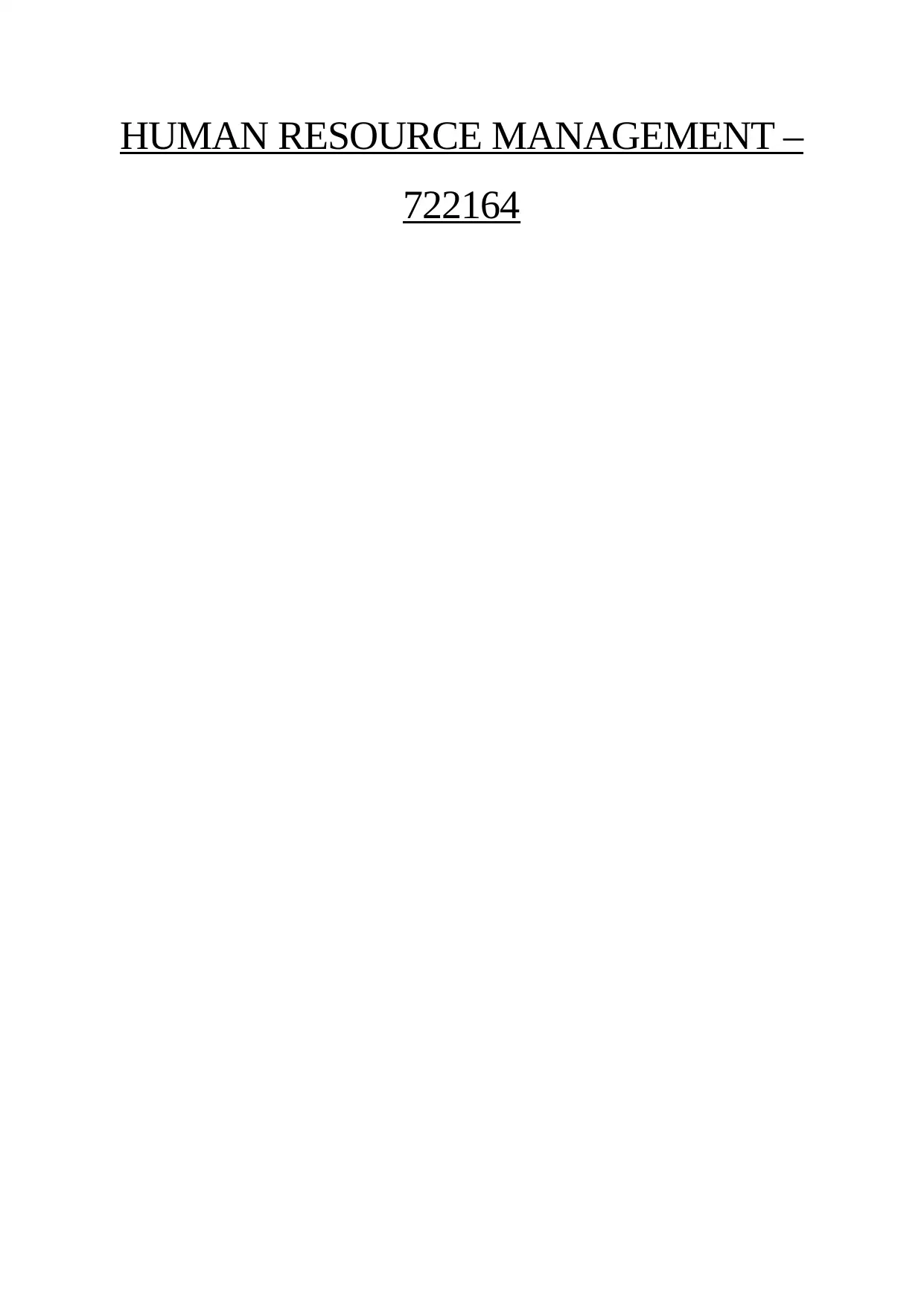
HUMAN RESOURCE MANAGEMENT –
722164
722164
Paraphrase This Document
Need a fresh take? Get an instant paraphrase of this document with our AI Paraphraser
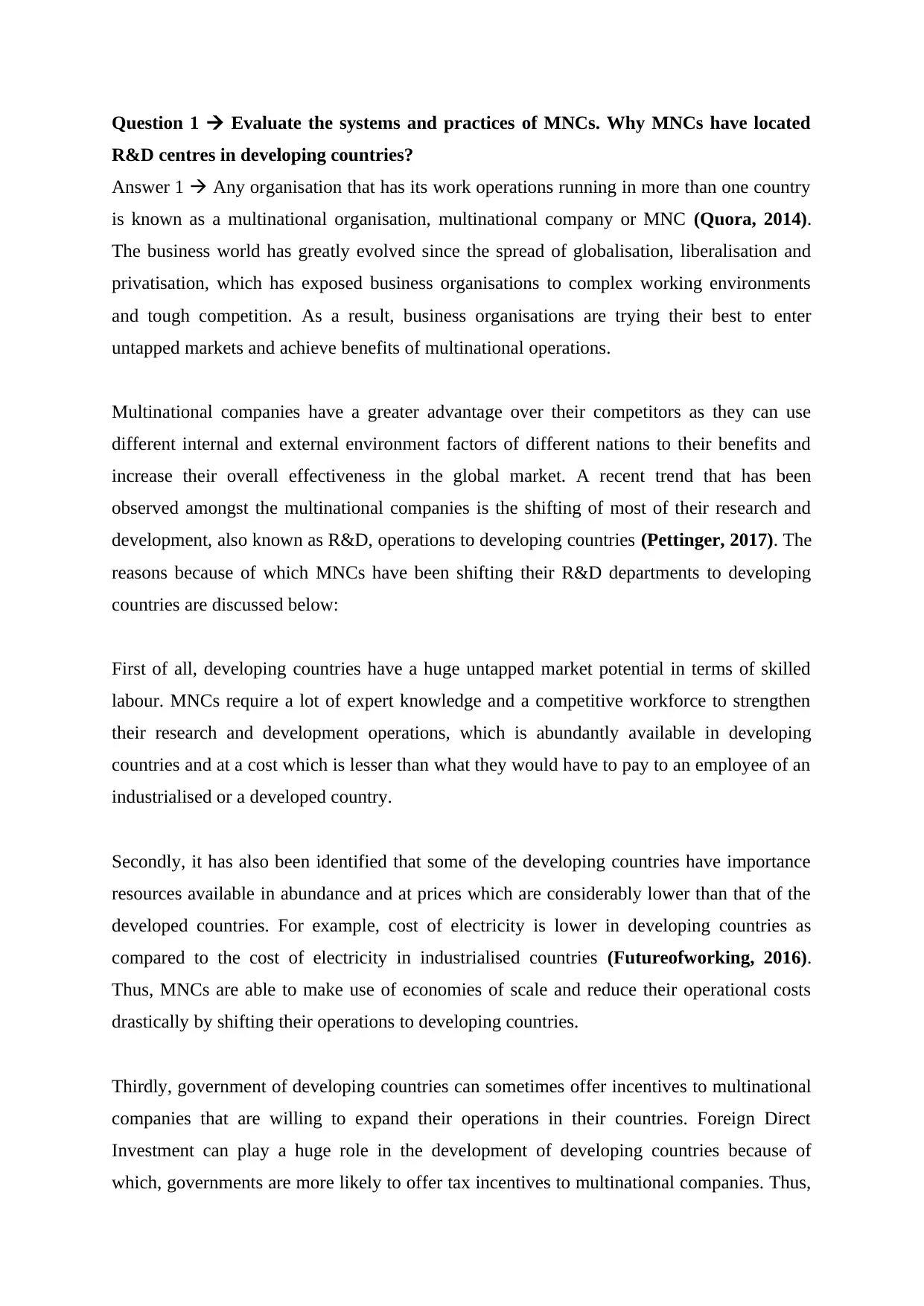
Question 1 Evaluate the systems and practices of MNCs. Why MNCs have located
R&D centres in developing countries?
Answer 1 Any organisation that has its work operations running in more than one country
is known as a multinational organisation, multinational company or MNC (Quora, 2014).
The business world has greatly evolved since the spread of globalisation, liberalisation and
privatisation, which has exposed business organisations to complex working environments
and tough competition. As a result, business organisations are trying their best to enter
untapped markets and achieve benefits of multinational operations.
Multinational companies have a greater advantage over their competitors as they can use
different internal and external environment factors of different nations to their benefits and
increase their overall effectiveness in the global market. A recent trend that has been
observed amongst the multinational companies is the shifting of most of their research and
development, also known as R&D, operations to developing countries (Pettinger, 2017). The
reasons because of which MNCs have been shifting their R&D departments to developing
countries are discussed below:
First of all, developing countries have a huge untapped market potential in terms of skilled
labour. MNCs require a lot of expert knowledge and a competitive workforce to strengthen
their research and development operations, which is abundantly available in developing
countries and at a cost which is lesser than what they would have to pay to an employee of an
industrialised or a developed country.
Secondly, it has also been identified that some of the developing countries have importance
resources available in abundance and at prices which are considerably lower than that of the
developed countries. For example, cost of electricity is lower in developing countries as
compared to the cost of electricity in industrialised countries (Futureofworking, 2016).
Thus, MNCs are able to make use of economies of scale and reduce their operational costs
drastically by shifting their operations to developing countries.
Thirdly, government of developing countries can sometimes offer incentives to multinational
companies that are willing to expand their operations in their countries. Foreign Direct
Investment can play a huge role in the development of developing countries because of
which, governments are more likely to offer tax incentives to multinational companies. Thus,
R&D centres in developing countries?
Answer 1 Any organisation that has its work operations running in more than one country
is known as a multinational organisation, multinational company or MNC (Quora, 2014).
The business world has greatly evolved since the spread of globalisation, liberalisation and
privatisation, which has exposed business organisations to complex working environments
and tough competition. As a result, business organisations are trying their best to enter
untapped markets and achieve benefits of multinational operations.
Multinational companies have a greater advantage over their competitors as they can use
different internal and external environment factors of different nations to their benefits and
increase their overall effectiveness in the global market. A recent trend that has been
observed amongst the multinational companies is the shifting of most of their research and
development, also known as R&D, operations to developing countries (Pettinger, 2017). The
reasons because of which MNCs have been shifting their R&D departments to developing
countries are discussed below:
First of all, developing countries have a huge untapped market potential in terms of skilled
labour. MNCs require a lot of expert knowledge and a competitive workforce to strengthen
their research and development operations, which is abundantly available in developing
countries and at a cost which is lesser than what they would have to pay to an employee of an
industrialised or a developed country.
Secondly, it has also been identified that some of the developing countries have importance
resources available in abundance and at prices which are considerably lower than that of the
developed countries. For example, cost of electricity is lower in developing countries as
compared to the cost of electricity in industrialised countries (Futureofworking, 2016).
Thus, MNCs are able to make use of economies of scale and reduce their operational costs
drastically by shifting their operations to developing countries.
Thirdly, government of developing countries can sometimes offer incentives to multinational
companies that are willing to expand their operations in their countries. Foreign Direct
Investment can play a huge role in the development of developing countries because of
which, governments are more likely to offer tax incentives to multinational companies. Thus,
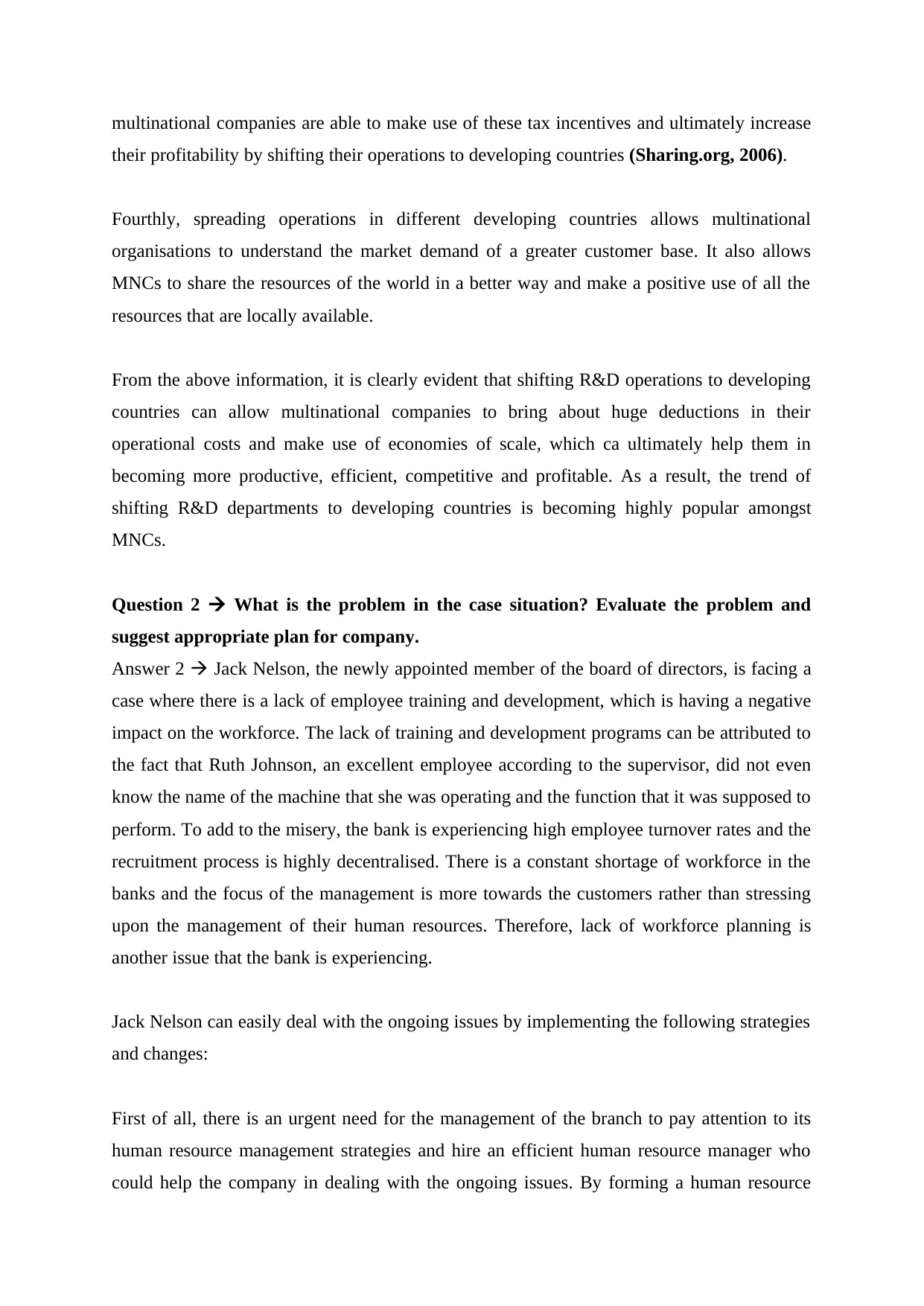
multinational companies are able to make use of these tax incentives and ultimately increase
their profitability by shifting their operations to developing countries (Sharing.org, 2006).
Fourthly, spreading operations in different developing countries allows multinational
organisations to understand the market demand of a greater customer base. It also allows
MNCs to share the resources of the world in a better way and make a positive use of all the
resources that are locally available.
From the above information, it is clearly evident that shifting R&D operations to developing
countries can allow multinational companies to bring about huge deductions in their
operational costs and make use of economies of scale, which ca ultimately help them in
becoming more productive, efficient, competitive and profitable. As a result, the trend of
shifting R&D departments to developing countries is becoming highly popular amongst
MNCs.
Question 2 What is the problem in the case situation? Evaluate the problem and
suggest appropriate plan for company.
Answer 2 Jack Nelson, the newly appointed member of the board of directors, is facing a
case where there is a lack of employee training and development, which is having a negative
impact on the workforce. The lack of training and development programs can be attributed to
the fact that Ruth Johnson, an excellent employee according to the supervisor, did not even
know the name of the machine that she was operating and the function that it was supposed to
perform. To add to the misery, the bank is experiencing high employee turnover rates and the
recruitment process is highly decentralised. There is a constant shortage of workforce in the
banks and the focus of the management is more towards the customers rather than stressing
upon the management of their human resources. Therefore, lack of workforce planning is
another issue that the bank is experiencing.
Jack Nelson can easily deal with the ongoing issues by implementing the following strategies
and changes:
First of all, there is an urgent need for the management of the branch to pay attention to its
human resource management strategies and hire an efficient human resource manager who
could help the company in dealing with the ongoing issues. By forming a human resource
their profitability by shifting their operations to developing countries (Sharing.org, 2006).
Fourthly, spreading operations in different developing countries allows multinational
organisations to understand the market demand of a greater customer base. It also allows
MNCs to share the resources of the world in a better way and make a positive use of all the
resources that are locally available.
From the above information, it is clearly evident that shifting R&D operations to developing
countries can allow multinational companies to bring about huge deductions in their
operational costs and make use of economies of scale, which ca ultimately help them in
becoming more productive, efficient, competitive and profitable. As a result, the trend of
shifting R&D departments to developing countries is becoming highly popular amongst
MNCs.
Question 2 What is the problem in the case situation? Evaluate the problem and
suggest appropriate plan for company.
Answer 2 Jack Nelson, the newly appointed member of the board of directors, is facing a
case where there is a lack of employee training and development, which is having a negative
impact on the workforce. The lack of training and development programs can be attributed to
the fact that Ruth Johnson, an excellent employee according to the supervisor, did not even
know the name of the machine that she was operating and the function that it was supposed to
perform. To add to the misery, the bank is experiencing high employee turnover rates and the
recruitment process is highly decentralised. There is a constant shortage of workforce in the
banks and the focus of the management is more towards the customers rather than stressing
upon the management of their human resources. Therefore, lack of workforce planning is
another issue that the bank is experiencing.
Jack Nelson can easily deal with the ongoing issues by implementing the following strategies
and changes:
First of all, there is an urgent need for the management of the branch to pay attention to its
human resource management strategies and hire an efficient human resource manager who
could help the company in dealing with the ongoing issues. By forming a human resource
⊘ This is a preview!⊘
Do you want full access?
Subscribe today to unlock all pages.

Trusted by 1+ million students worldwide
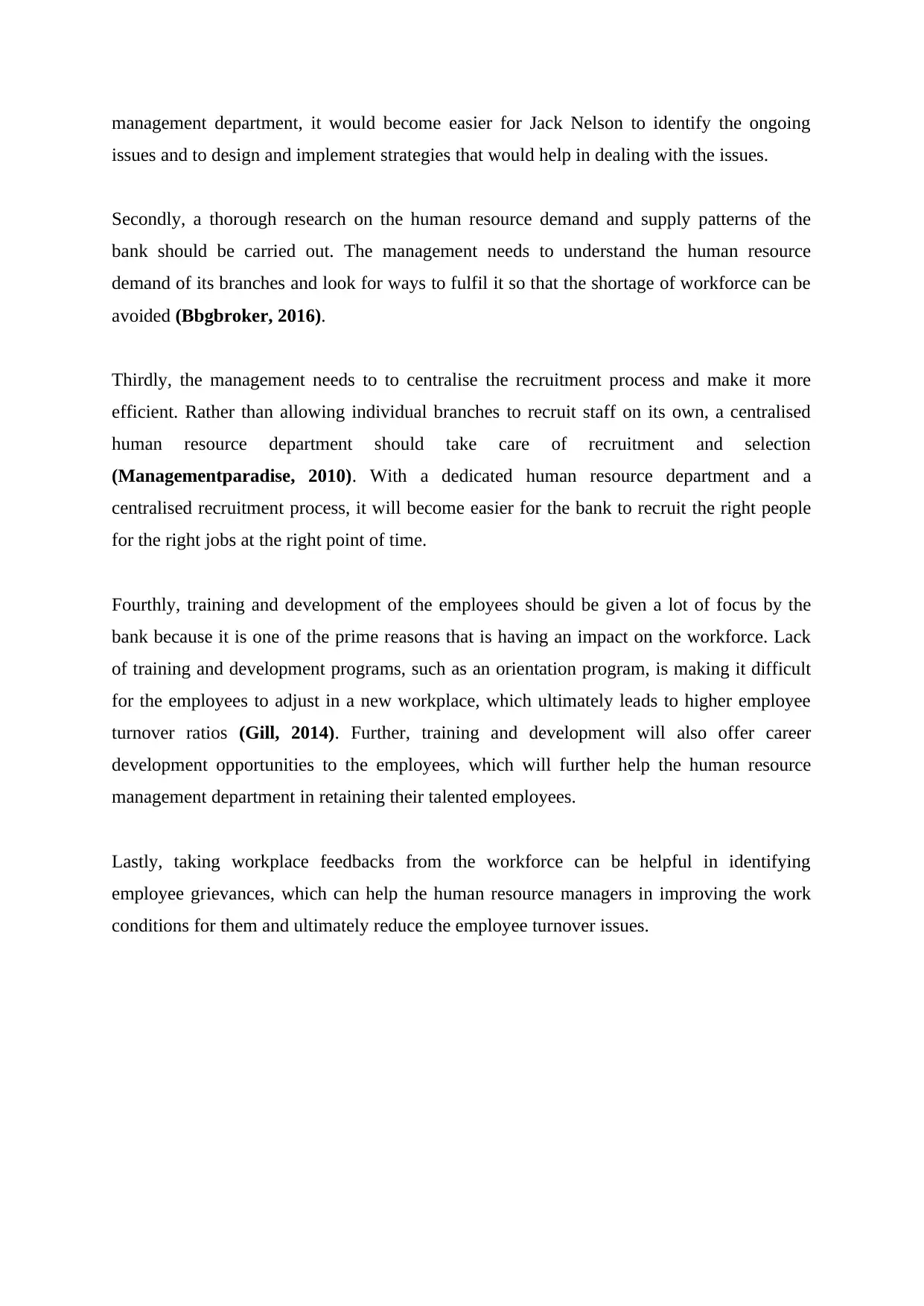
management department, it would become easier for Jack Nelson to identify the ongoing
issues and to design and implement strategies that would help in dealing with the issues.
Secondly, a thorough research on the human resource demand and supply patterns of the
bank should be carried out. The management needs to understand the human resource
demand of its branches and look for ways to fulfil it so that the shortage of workforce can be
avoided (Bbgbroker, 2016).
Thirdly, the management needs to to centralise the recruitment process and make it more
efficient. Rather than allowing individual branches to recruit staff on its own, a centralised
human resource department should take care of recruitment and selection
(Managementparadise, 2010). With a dedicated human resource department and a
centralised recruitment process, it will become easier for the bank to recruit the right people
for the right jobs at the right point of time.
Fourthly, training and development of the employees should be given a lot of focus by the
bank because it is one of the prime reasons that is having an impact on the workforce. Lack
of training and development programs, such as an orientation program, is making it difficult
for the employees to adjust in a new workplace, which ultimately leads to higher employee
turnover ratios (Gill, 2014). Further, training and development will also offer career
development opportunities to the employees, which will further help the human resource
management department in retaining their talented employees.
Lastly, taking workplace feedbacks from the workforce can be helpful in identifying
employee grievances, which can help the human resource managers in improving the work
conditions for them and ultimately reduce the employee turnover issues.
issues and to design and implement strategies that would help in dealing with the issues.
Secondly, a thorough research on the human resource demand and supply patterns of the
bank should be carried out. The management needs to understand the human resource
demand of its branches and look for ways to fulfil it so that the shortage of workforce can be
avoided (Bbgbroker, 2016).
Thirdly, the management needs to to centralise the recruitment process and make it more
efficient. Rather than allowing individual branches to recruit staff on its own, a centralised
human resource department should take care of recruitment and selection
(Managementparadise, 2010). With a dedicated human resource department and a
centralised recruitment process, it will become easier for the bank to recruit the right people
for the right jobs at the right point of time.
Fourthly, training and development of the employees should be given a lot of focus by the
bank because it is one of the prime reasons that is having an impact on the workforce. Lack
of training and development programs, such as an orientation program, is making it difficult
for the employees to adjust in a new workplace, which ultimately leads to higher employee
turnover ratios (Gill, 2014). Further, training and development will also offer career
development opportunities to the employees, which will further help the human resource
management department in retaining their talented employees.
Lastly, taking workplace feedbacks from the workforce can be helpful in identifying
employee grievances, which can help the human resource managers in improving the work
conditions for them and ultimately reduce the employee turnover issues.
Paraphrase This Document
Need a fresh take? Get an instant paraphrase of this document with our AI Paraphraser
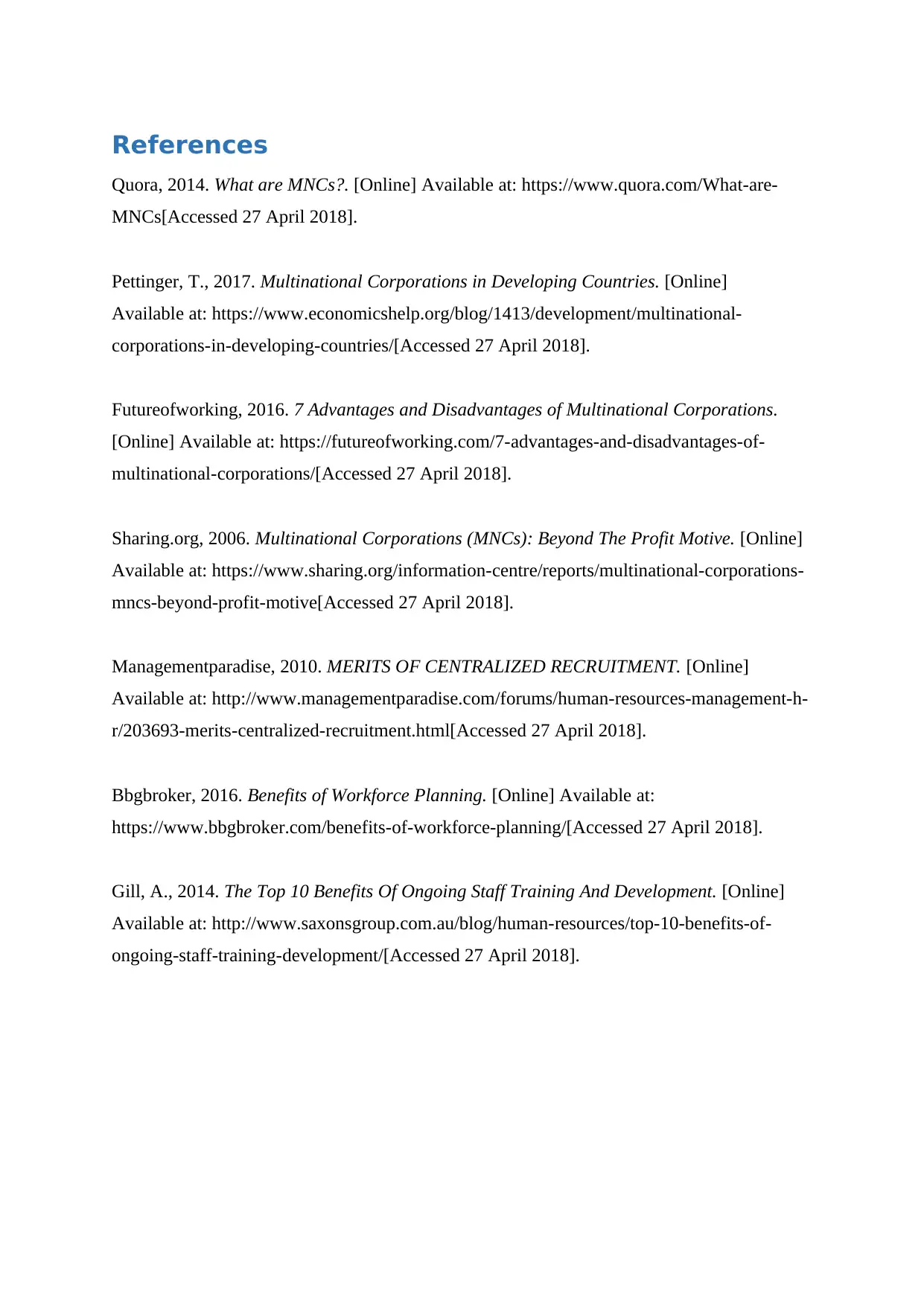
References
Quora, 2014. What are MNCs?. [Online] Available at: https://www.quora.com/What-are-
MNCs[Accessed 27 April 2018].
Pettinger, T., 2017. Multinational Corporations in Developing Countries. [Online]
Available at: https://www.economicshelp.org/blog/1413/development/multinational-
corporations-in-developing-countries/[Accessed 27 April 2018].
Futureofworking, 2016. 7 Advantages and Disadvantages of Multinational Corporations.
[Online] Available at: https://futureofworking.com/7-advantages-and-disadvantages-of-
multinational-corporations/[Accessed 27 April 2018].
Sharing.org, 2006. Multinational Corporations (MNCs): Beyond The Profit Motive. [Online]
Available at: https://www.sharing.org/information-centre/reports/multinational-corporations-
mncs-beyond-profit-motive[Accessed 27 April 2018].
Managementparadise, 2010. MERITS OF CENTRALIZED RECRUITMENT. [Online]
Available at: http://www.managementparadise.com/forums/human-resources-management-h-
r/203693-merits-centralized-recruitment.html[Accessed 27 April 2018].
Bbgbroker, 2016. Benefits of Workforce Planning. [Online] Available at:
https://www.bbgbroker.com/benefits-of-workforce-planning/[Accessed 27 April 2018].
Gill, A., 2014. The Top 10 Benefits Of Ongoing Staff Training And Development. [Online]
Available at: http://www.saxonsgroup.com.au/blog/human-resources/top-10-benefits-of-
ongoing-staff-training-development/[Accessed 27 April 2018].
Quora, 2014. What are MNCs?. [Online] Available at: https://www.quora.com/What-are-
MNCs[Accessed 27 April 2018].
Pettinger, T., 2017. Multinational Corporations in Developing Countries. [Online]
Available at: https://www.economicshelp.org/blog/1413/development/multinational-
corporations-in-developing-countries/[Accessed 27 April 2018].
Futureofworking, 2016. 7 Advantages and Disadvantages of Multinational Corporations.
[Online] Available at: https://futureofworking.com/7-advantages-and-disadvantages-of-
multinational-corporations/[Accessed 27 April 2018].
Sharing.org, 2006. Multinational Corporations (MNCs): Beyond The Profit Motive. [Online]
Available at: https://www.sharing.org/information-centre/reports/multinational-corporations-
mncs-beyond-profit-motive[Accessed 27 April 2018].
Managementparadise, 2010. MERITS OF CENTRALIZED RECRUITMENT. [Online]
Available at: http://www.managementparadise.com/forums/human-resources-management-h-
r/203693-merits-centralized-recruitment.html[Accessed 27 April 2018].
Bbgbroker, 2016. Benefits of Workforce Planning. [Online] Available at:
https://www.bbgbroker.com/benefits-of-workforce-planning/[Accessed 27 April 2018].
Gill, A., 2014. The Top 10 Benefits Of Ongoing Staff Training And Development. [Online]
Available at: http://www.saxonsgroup.com.au/blog/human-resources/top-10-benefits-of-
ongoing-staff-training-development/[Accessed 27 April 2018].
1 out of 5
Related Documents
Your All-in-One AI-Powered Toolkit for Academic Success.
+13062052269
info@desklib.com
Available 24*7 on WhatsApp / Email
![[object Object]](/_next/static/media/star-bottom.7253800d.svg)
Unlock your academic potential
Copyright © 2020–2025 A2Z Services. All Rights Reserved. Developed and managed by ZUCOL.





